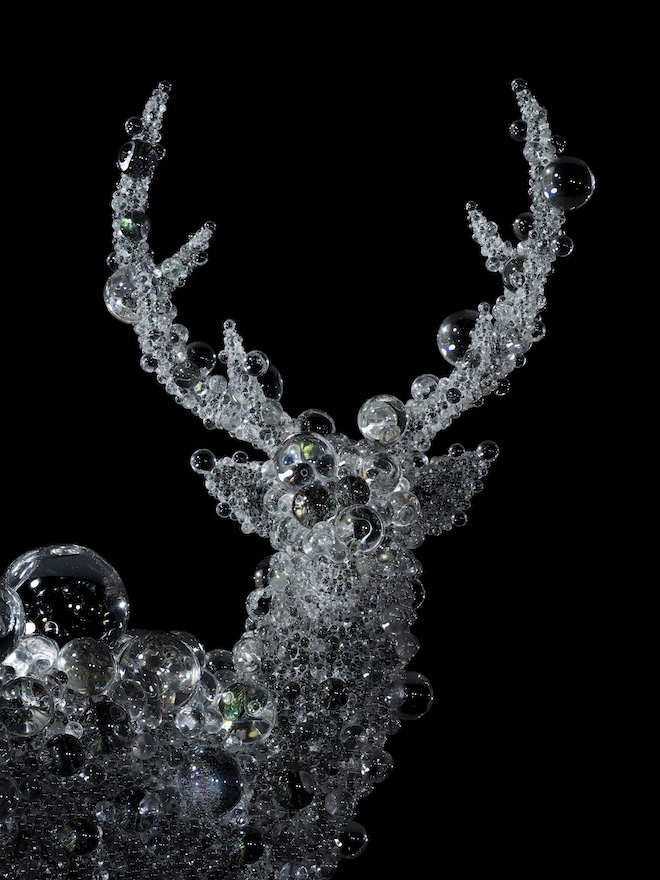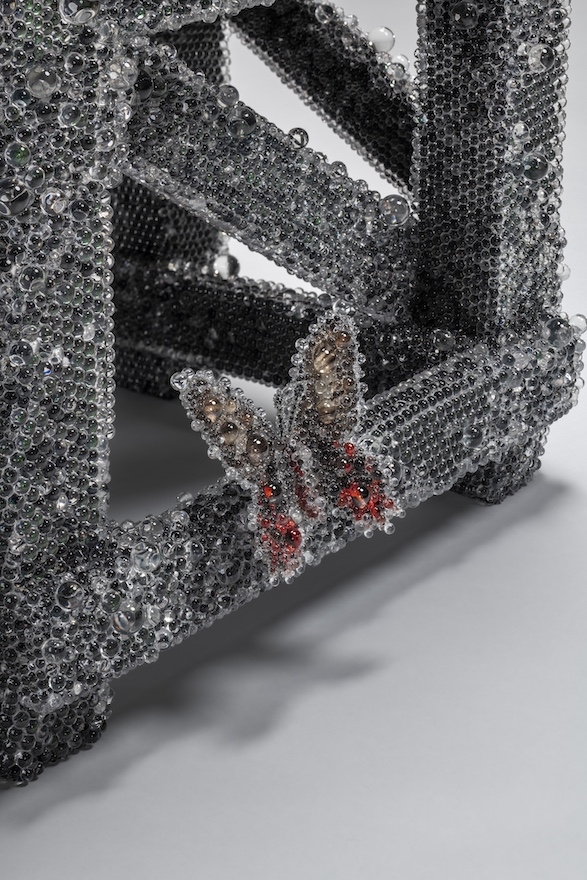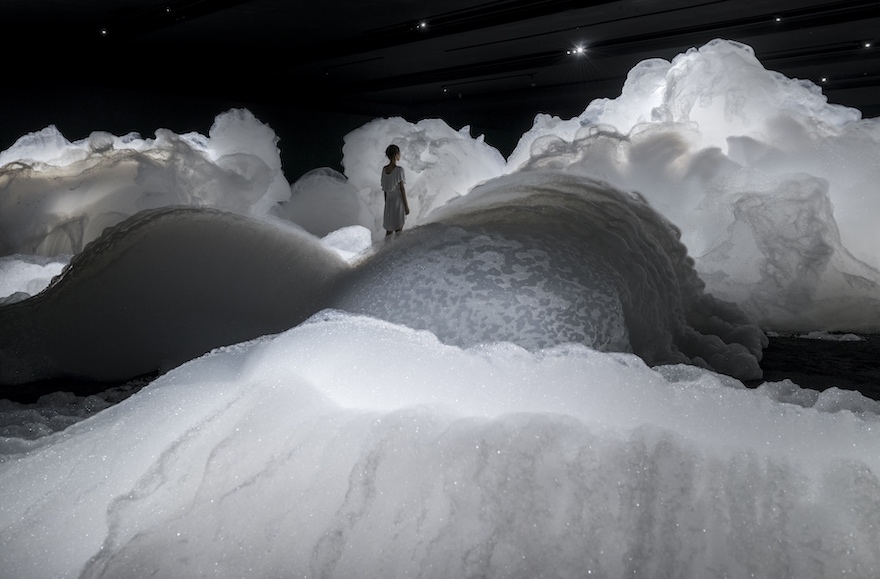Cultural Currency 29: Damien Jalet / Nawa Kohei: Mirage [transitory]
Life and death, symmetry breaking
By Shimizu Minoru
2024.11.05

Damien Jalet | Kohei Nawa
Photo: Yoshikazu Inoue
Several years ago, I saw some photographic works shot by Nawa Kohei when he was in university or graduate school (between the late 1990s and 2000).1 These works embodied the aspirations of a young artist intent on engaging with single, irreplaceable things (objects, people) and turning their sense of presence, or the sense of loss stemming from their absence, into artworks.
PixCell, however, which earned an honorable mention at the 2003 Kirin Art Awards, was a work with no connection whatsoever to the green narcissism of being drawn to “irreplaceable single entities.” Just as at one point On Kawara abandoned all ideas for artmaking and embarked on his “Today” series,2 it was after abandoning his preference for “irreplaceable entities” that are “unique in all the world” that Nawa Kohei became the artist he is today.

 Nawa’s works are consistently realized based on concepts and processes derived from the properties of the materials. The concept behind the “PixCell” series involves covering random objects with beads, which both act as lenses capturing images and mimic pixels of various sizes, representing an aspect of an age in which actually existing things are consolidated as digital pixels and circulate weakly as entities divorced from reality. Since then, he has continued to apply a consistent methodology to creating artworks, while making fine adjustments to material properties and physical laws. By adjusting the gravitational force acting on a certain kind of ink as it drips, stripe paintings result, and depending on the foaming properties of a certain kind of resin, shell-like objects are formed. The essence of this practice lies in the process of creating the works; the content is essentially interchangeable and must not contain any specific meaning. A deer PixCell and butterfly PixCell are of equal value.
At the starting point for the process of transforming the various formative elements that derive from physical properties into artworks there is nothing but the eternal natural principles that exist independently of human beings. From among these various formative elements, the artist ultimately picks out things that can be seen as beauty. The works are formed based on natural logic in accordance with processes that are clearly cut off from the artist’s insignificant viewpoints, thoughts and concepts. Because natural logic is not concerned with human meaning, the works, too, are essentially unrelated to meaning, and even if something like meaning existed it would be no more than something attached afterwards. Nawa’s works are graceful and beautiful. And (not “but”) as repeated natural phenomena they are meaningless and empty.
Nawa’s works are consistently realized based on concepts and processes derived from the properties of the materials. The concept behind the “PixCell” series involves covering random objects with beads, which both act as lenses capturing images and mimic pixels of various sizes, representing an aspect of an age in which actually existing things are consolidated as digital pixels and circulate weakly as entities divorced from reality. Since then, he has continued to apply a consistent methodology to creating artworks, while making fine adjustments to material properties and physical laws. By adjusting the gravitational force acting on a certain kind of ink as it drips, stripe paintings result, and depending on the foaming properties of a certain kind of resin, shell-like objects are formed. The essence of this practice lies in the process of creating the works; the content is essentially interchangeable and must not contain any specific meaning. A deer PixCell and butterfly PixCell are of equal value.
At the starting point for the process of transforming the various formative elements that derive from physical properties into artworks there is nothing but the eternal natural principles that exist independently of human beings. From among these various formative elements, the artist ultimately picks out things that can be seen as beauty. The works are formed based on natural logic in accordance with processes that are clearly cut off from the artist’s insignificant viewpoints, thoughts and concepts. Because natural logic is not concerned with human meaning, the works, too, are essentially unrelated to meaning, and even if something like meaning existed it would be no more than something attached afterwards. Nawa’s works are graceful and beautiful. And (not “but”) as repeated natural phenomena they are meaningless and empty.
 However, the installation Nawa presented at the 2013 Aichi Triennale whose form changed moment by moment indicated that the artist had once again turned in the direction of that “irreplaceable” “onceness.” Damien Jalet, who noticed this orientation, contacted Nawa. The filling of the above-mentioned meaningless and emptiness was accomplished through a collaboration fusing sculpture and the performing arts.3 Nawa regained his “irreplaceable onceness” as an extension of his own methodology.
However, the installation Nawa presented at the 2013 Aichi Triennale whose form changed moment by moment indicated that the artist had once again turned in the direction of that “irreplaceable” “onceness.” Damien Jalet, who noticed this orientation, contacted Nawa. The filling of the above-mentioned meaningless and emptiness was accomplished through a collaboration fusing sculpture and the performing arts.3 Nawa regained his “irreplaceable onceness” as an extension of his own methodology.


 In general, we imagine shapes formed from regular straight lines and circles as artificial, and shapes made of irregular curves as natural. This is why when regular shapes that appear to have been made by humans are discovered in nature, they become tourist attractions (e.g. the hexagonally jointed basalt columns at Fingal’s Cave). However, at the micro and macro levels, nature includes all kinds of shapes. The difference between artificiality and nature is that, whereas humans distinguish between straight lines and curves, and between regular and irregular, in nature there are no such distinctions.
In general, we imagine shapes formed from regular straight lines and circles as artificial, and shapes made of irregular curves as natural. This is why when regular shapes that appear to have been made by humans are discovered in nature, they become tourist attractions (e.g. the hexagonally jointed basalt columns at Fingal’s Cave). However, at the micro and macro levels, nature includes all kinds of shapes. The difference between artificiality and nature is that, whereas humans distinguish between straight lines and curves, and between regular and irregular, in nature there are no such distinctions.
 However, as well as being under the control of humans, the human body is also subject to the laws of nature (physical laws such as gravity, physiological/medical processes, etc.). The human body, and the art of dance that employs the human body, are realms of struggle (not hostility) between humans and nature. The freedom of the dancing body is none other than the result of the competition, negotiation and appeasement with nature that is the human body. It is probably only natural that Jalet found in Nawa an outstanding partner. In the sense that they derive directly from the properties of their materials, Nawa’s sculptures belong to the world of nature, or to the world of the symmetry of omnidirectional chaos. Dance as a struggle between humans and nature is also the struggle between dance (Jalet) and sculpture (Nawa), and is also connected to eroticism in the form of the struggle between life and death that is the unmistakable subject matter of this work.
However, as well as being under the control of humans, the human body is also subject to the laws of nature (physical laws such as gravity, physiological/medical processes, etc.). The human body, and the art of dance that employs the human body, are realms of struggle (not hostility) between humans and nature. The freedom of the dancing body is none other than the result of the competition, negotiation and appeasement with nature that is the human body. It is probably only natural that Jalet found in Nawa an outstanding partner. In the sense that they derive directly from the properties of their materials, Nawa’s sculptures belong to the world of nature, or to the world of the symmetry of omnidirectional chaos. Dance as a struggle between humans and nature is also the struggle between dance (Jalet) and sculpture (Nawa), and is also connected to eroticism in the form of the struggle between life and death that is the unmistakable subject matter of this work.


 Because nature, which neither arises nor ceases, is a world in which there is no distinction between life and death, it knows neither “life,” a concept of mortals, nor “death” (both of which are tinged with signs of “onceness”). In contrast, the stage on which Mirage [transitory] is performed is clearly made up of two kinds of symmetry. The first is line symmetry with an axis of symmetry (the massive crevice (vagina?) that rises up at the end, the complex symmetrical forms of the male and female figures as they intertwine with one another while dancing), and the second is point symmetry around a central point (the combative (?) dancing of performers formed into several pairs; the miraculous, sea anemone-like group dancing involving upper bodies and arms around a hole formed at the front of the stage). In this work, Jalet has created symmetrical dancing involving male and female, life and death, and light and dark in the human world, the world after the breaking of symmetry. On a darkened stage, the performers continue to dance while writhing like the statues of Laocoön and his sons, making the scales attached to their bodies glitter, and intertwining with one another like the Hindu gods Shiva and Parvati, until eventually from a hole in front of the principal male and female dancers who have come together a double helix (DNA?) rises like a hologram. In other words, the struggle played out between human symmetry leads to the future through reproduction. Is this, too, nothing more than a mirage in the face of the vast natural world?
Overall, it was a well-organized performance, but consisted solely of a performance of human symmetry (male/female, life/death, etc.), failing to get to the struggle between this and the symmetry of nature. In a similar vein, the scenography was limited to visual effects (a silver powder show?), and I got the sense that the kind of talent Nawa has of using the essence of materials as seen in Planet [wanderer] was not fully demonstrated. But this may be because this performance is still a “transitory” version.
Ferruccio Busoni said, “Music is sonorous air.” Is not the essence of music and the performing arts “onceness” that does not end in sameness? While overdue, I welcome the fact that through its encounter with the performing arts, Nawa Kohei’s art is open to this kind of “onceness.”
Because nature, which neither arises nor ceases, is a world in which there is no distinction between life and death, it knows neither “life,” a concept of mortals, nor “death” (both of which are tinged with signs of “onceness”). In contrast, the stage on which Mirage [transitory] is performed is clearly made up of two kinds of symmetry. The first is line symmetry with an axis of symmetry (the massive crevice (vagina?) that rises up at the end, the complex symmetrical forms of the male and female figures as they intertwine with one another while dancing), and the second is point symmetry around a central point (the combative (?) dancing of performers formed into several pairs; the miraculous, sea anemone-like group dancing involving upper bodies and arms around a hole formed at the front of the stage). In this work, Jalet has created symmetrical dancing involving male and female, life and death, and light and dark in the human world, the world after the breaking of symmetry. On a darkened stage, the performers continue to dance while writhing like the statues of Laocoön and his sons, making the scales attached to their bodies glitter, and intertwining with one another like the Hindu gods Shiva and Parvati, until eventually from a hole in front of the principal male and female dancers who have come together a double helix (DNA?) rises like a hologram. In other words, the struggle played out between human symmetry leads to the future through reproduction. Is this, too, nothing more than a mirage in the face of the vast natural world?
Overall, it was a well-organized performance, but consisted solely of a performance of human symmetry (male/female, life/death, etc.), failing to get to the struggle between this and the symmetry of nature. In a similar vein, the scenography was limited to visual effects (a silver powder show?), and I got the sense that the kind of talent Nawa has of using the essence of materials as seen in Planet [wanderer] was not fully demonstrated. But this may be because this performance is still a “transitory” version.
Ferruccio Busoni said, “Music is sonorous air.” Is not the essence of music and the performing arts “onceness” that does not end in sameness? While overdue, I welcome the fact that through its encounter with the performing arts, Nawa Kohei’s art is open to this kind of “onceness.”
——————————–
1. Nawa Kohei “Wandering,” held June 5–July 3, 2021, at Taka Ishii Gallery Photography / Film.
2. As documented in On Kawara, 1964. Paris-New York Drawings (Kunstmuseum St.Gallen, 1997).
3. According to Nawa, the model for his first collaboration with Jalet, Vessel, dates back to sculptures from his university days inspired by the pelvis and uterus. ——————————–
Shimizu Minoru
Critic. Professor, Doshisha University
Damien Jalet / Nawa Kohei: Mirage [transitory] was held from September 27 – October 6, 2024 at THEATER 010, Hakata, Fukuoka. This review was written based on the September 27 performance.

PixCell-Deer#69 (Aurora)
2022, mixed media, 2097×1566×783 mm

PixCell-TV/Butterfly/Wood Stand
2023, mixed media, 770×517×444 mm
photos: Nobutada OMOTE

Foam
2013, mixed media, dimensions variable
Installation view: “AICHI TRIENNALE 2013,” Aichi, Japan, 2013, Courtesy of Aichi Triennale 2013 and Sandwich
photo: Nobutada OMOTE
*
According to the Big Bang theory, the reason given for why, when the universe came into being, matter and antimatter did not annihilate each other resulting in everything turning back into nothing, but that matter remained in the universe (the reason why the universe is not “absent” but “present”) is “symmetry breaking,” though this term tends to invite misunderstanding. Primordial symmetry could perhaps best be described as a state of complete chaos in which symmetry existed in every direction from every viewpoint in space. This symmetry was maintained by the highest energy at the early stage of the universe. “Symmetry breaking” refers to the process whereby this was broken and a shift occurred to a low energy state, or in other words to a state in which symmetry was limited to the direction in which one looked from a particular viewpoint only. Line symmetry and point symmetry are “humanistic” forms that date from after this “symmetry breaking.”


Mirage [transitory]
Damien Jalet | Kohei Nawa
All photos: Yoshikazu Inoue

Mirage [transitory]
Damien Jalet | Kohei Nawa
Photo: Yoshikazu Inoue



Mirage [transitory]
Damien Jalet | Kohei Nawa
All photos: Yoshikazu Inoue
——————————–
1. Nawa Kohei “Wandering,” held June 5–July 3, 2021, at Taka Ishii Gallery Photography / Film.
2. As documented in On Kawara, 1964. Paris-New York Drawings (Kunstmuseum St.Gallen, 1997).
3. According to Nawa, the model for his first collaboration with Jalet, Vessel, dates back to sculptures from his university days inspired by the pelvis and uterus. ——————————–
Shimizu Minoru
Critic. Professor, Doshisha University
Damien Jalet / Nawa Kohei: Mirage [transitory] was held from September 27 – October 6, 2024 at THEATER 010, Hakata, Fukuoka. This review was written based on the September 27 performance.